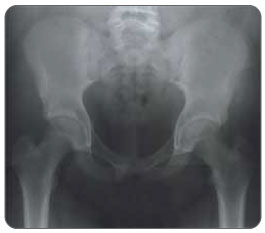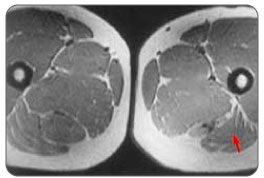|
| Diagnosing a Hamstring StrainCommon Hamstring Injury Diagnostic Tests:Most grade 1 or 2 hamstring strains don't require diagnostic testing, however these tests will help confirm if you have a grade 3 strain and/or will rule out other causes of hamstring pain.  X-rays will provide a two-dimensional image of the overall structure of your hamstring and upper leg (pelvis, femur and knee). They are helpful in identifying instability, avulsion fractures, abnormal bone shapes (bone spurs, calcifications or cysts, joint degeneration), and/or other leg problems. CT scans (computed tomography) and diagnostic ultrasounds may be used to look internally at the hamstring muscles.  MRIs (magnetic resonance imaging) will provide more detailed information and will help to evaluate the soft tissues in and around your hamstring (muscles, tendons, ligaments, fascia, and other connective tissues). They can identify ligament or tendon damage, and can help to determine the extent of your injury, the grade of your tear or inflammation, as well as other associated conditions. Strained Hamstring TreatmentsHamstring injuries are frustrating to live with and healing can take a long time because it's difficult to give your leg the rest it needs. This is especially true for runners and other athletes that return to their sport too early. Re-injury is common but it prolongs recovery and may also lead to permanent damage and other conditions. Treating your hamstring strain correctly is essential to getting rid of your pain and restoring function to your upper thigh. Proper treatment will get you back to regular activities sooner, stop your pain, and reduce the risk of future re-injury. To restore strength and range of motion in your hamstrings, treatment should focus on preventing scar tissue formation and muscle atrophy (shrinkage and weakening of the muscle). This requires rest and the appropriate therapies at the right time. Almost all types of hamstring pulls and tears (except a complete hamstring rupture) can be properly treated with trusted therapies that are available for use at home. Complete ruptures usually require surgery. However, using these home therapies after surgery can help speed recovery, improve function, and increase range of motion in your hamstrings. Learn More About Hamstring StrainHamstring Strain Causes Hamstring Strain Symptoms Hamstring Strain Progression (Grades of Strain) Hamstring Strain Diagnosis Hamstring Strain Home Treatments Hamstring Strain Surgery Hamstring Strain Post-Surgery Recovery Hamstring Strain Prevention Product specialists are available 9:00 am to 5:00 pm Eastern Standard Time Monday to Friday. If any question or concern arises, call us or simply send us an email at any time (we check our emails constantly all throughout the day and night.. even on holidays!). We will respond as soon as possible. North America Toll Free 1-866-237-9608 |
    |

